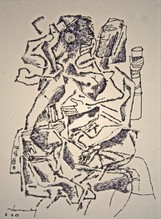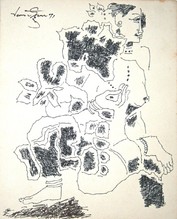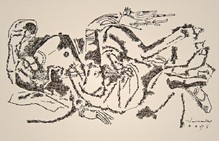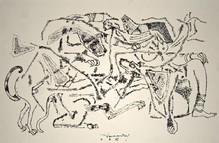
-
From 01 May-2009 To 30 Jun-2009
-
From 17 Jan-2007 To 14 Apr-2007
-
From 05 Nov-2015 To 08 Nov-2015
-
From 10 Sep-2016 To 29 Oct-2016
-
From 11 Jan-2022 To 18 Jan-2022
-
From 14 Jul-2023 To 23 Jul-2023
Achieved diploma in Fine Arts from Government College of Arts and Crafts, Madras in 1953; Postgraduate Advanced Painting qualification acquired at same college in 1955; Appointed lecturer at the Madras Government College in 1958 and Principal of the Kumbakonam College of Arts and Crafts in 1978; Appointed Principal of Madras Government College from 1985 to 1990
Selected Exhibitions
Mapping the South Exhibition, Vinyasa Art Gallery, Chennai, Delhi & Bangalore (2006); Expressions: The Art Within, Kasthuri Srinivasan Art Gallery, Coimbatore (2005); Retrospective Exhibition, CMC Art Gallery (1990); Appointed Commissioner for Brazil Triennale organised by Lalit Kala Akademi, New Delhi (1988); Commonwealth Art Exhibition, London (1967); Three Indian Painters, The British Council, Madras (1966)
Selected Awards
Kala Rathna Award, AIFACS, New Delhi (1997); Kalaimamani Award, Government of Tamil Nadu, Madras (1995); Kalai Chammal Award, Tamil Nadu(1983); Kerala State Award (1978); Veteran Artist Award, AIFACS, New Delhi (1962); Gold Medal, Indian Fine Arts Society, Calcutta (1958); National Award,Lalit Kala Akademi, New Delhi (1957 & 1962); Government of India Scholarship for Postgraduate study (1954-6); Gold Medal, Government College of Artsand Crafts, Madras (1953)
"A line is a line, it is universal" - A.P. Santhanaraj
"There was something Indian even in a line" - A.P. Santhanaraj
"I am hungry about painting. What comes out of it, I don't know. All my intentions are not to accept a preconceived form. Circumstances force me to accept a particular form. - A. P. Santhanaraj
Professor Santhanaraj is considered by many in South India to be the most influential artist of the second wave that followed K.C.S.Panniker and S. Dhanapal out of the Madras College of Arts and Craft. Santhanaraj quickly forged an artistic style of his own dedicated to ascertaining the various complexities of pictorial space through abstract engagement with figurative subject matter. From student days, Santhanaraj would always approach a canvas with passion, aggression and enthusiasm. Students even now remember how magical colour, line and form would flow from him whatever the emotional stimulus. Crucial to his work from the start was his love of line: its meandering through pictorial space, defining and dividing in its wake, shaping and destroying form, aiding and inhibiting light and colour. His spontaneous free line inspired his colour palette and also archetypes to emerge, especially the buxom female heroine. She would appear from his subconscious through the jagged lines and the spatial areas they displaced along the way. To his last days, Santhanaraj experimented with the concept of abstraction first and, from this process, the emergence of unconscious figuration. His paintings began with the placement of random pieces of paper on the canvas. These are moved around the pictorial space whilst the canvas itself is intermittently rotated and inspected from all angles. The methodology reveals symmetry with Jackson Pollock, a painter who in his abstraction would circle the canvas on the floor like a panther meeting its prey.











